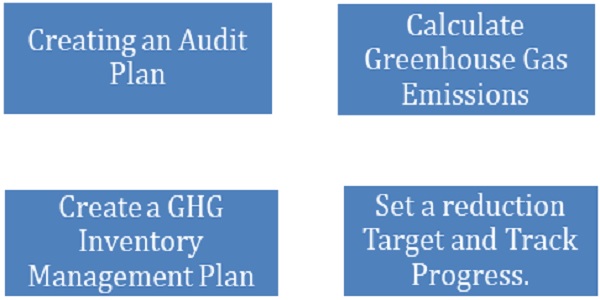Introduction
In this article, we delve into the vital realm of auditing Greenhouse Gas (GHG) emissions and its profound impact on emission reduction. Beyond legal mandates, accurate accounting is paramount, given potential legal liabilities. Discover how organizations, through proper auditing, can lead in climate change mitigation, saving costs, enhancing productivity, and lowering GHG emissions.
Companies report GHG emissions for a number of reasons, both legally mandated and voluntary, and in a number of contexts. Accurate accounting and reporting are critical because inaccuracies in emissions reporting can potentially expose the reporting entity to several types of legal liability.
Organizations can take a leading role in helping to reduce the risks of climate change by implementing actions that save money, improve productivity, and lower greenhouse gas (GHG) emissions.
So, to assist the organizations to reduce the emissions, the Greenhouse Gas Protocol was jointly convened in 1998 by World Business Council for Sustainable Development (WBCSD) and World Resources Institute (WRI).
This Protocol helps in managing the GHG inventories with the following steps:-

♦ Creating an Audit Plan: –
Audit Plan refers to developing a general strategy and a detailed approach to presume the expected nature, timing and extent of audit. The auditor plans to perform the audit in an efficient and timely manner.
♦ Creating a GHG Inventory Management Plan (IMP): –
A. Documenting Inventory Procedures: –
This is a useful tool for accurately documenting the process that are been used to collect the GHG inventory data, so that a high-quality inventory can be completed year after year. Organizations develop and maintain an IMP that describes their process for completing a high-quality, corporate-wide inventory. The IMP is a protocol developed by each organization which addresses their unique procedures for creating a credible corporate-wide GHG emissions inventory on an annual basis.
B. GHG Inventory Management Plan (IMP): –
The Inventory Management Plan (IMP) is available for the organizations to determine their GHG emissions. It is presented in a basic format and some items in the form have been pre-populated with default responses consistent with the use of the Calculator.
The seven major components of an IMP are:
1. Organization Information: This section provides general organizational information such as organization name, corporate address and inventory contact information.
2. Boundary Conditions: An inventory boundary identifies the gases, emissions sources, geographic area and time span. It is designed to provide an entity with a comprehensive understanding of where emissions are coming from as well as an indication of where it can take action or influence change.
3. Data Management: The tools provide an understanding whether the data sources are reliable, from where the data are been collected and processed, and also the quality assurance.
4. Management Tools: The management tools serve to identify the roles and responsibilities, training procedures, and file maintenance procedures of the organization.
5. Auditing & Verification: Identifies procedures for auditing (internal and external), management review, and how corrective actions are taken.
Apart from the above inventory management plan, the Greenhouse Gas Protocol has laid down certain measures in reducing the GHG Emissions and track them annually using recommended tools. Those measures are as follows: –

1. Annual GHG Inventory Summary and Target Tracking Form: –
Organizations can track GHG emissions annually by completing the Annual GHG Inventory Summary and Target Tracking Form. The company can enter the Calculation summary in the Annual Reporting Form without any further conversions or calculations.
2. Setting a GHG Reduction Target: –
Setting a target is a tangible action that communicates to stakeholders an organization’s climate strategy and commitment. Having a target can motivate staff, help drive long-term strategies, and save money for the organization through energy efficiency projects. A target can be set using either location-based or market-based emissions.
3. Determining the type of target: –
Targets can be expressed as an absolute GHG emissions reduction or as a decrease in GHG intensity. Absolute GHG reduction targets compare total GHG emissions in the target year to those in a base year. GHG intensity targets allow an organization to account for increases or decreases in production, square footage, or other metric over time.
4. Going Carbon Neutral: –
In addition to absolute and intensity-based GHG reduction targets, some organizations set a target to be carbon neutral, which is a commitment to achieve and maintain net zero GHG emissions in an organization’s operations.
A carbon neutral target should include the following:
i. Have a Robust and Transparent GHG inventory.
ii. Look for opportunities to reduce the reporting organization’s emissions.
iii. Purchase green power, renewable energy certificates (RECs).
5. Environmental Protection Agency (EPA) Resources for Reducing GHG Emissions: –
The Centre website provides a list of resources to help organizations meet their GHG reduction targets, including those listed below: –
♦ Energy Efficiency Resources:
- EPA ENERGY STAR Program
- EPA Combined Heat and Power Partnership
- Department of Energy resources
♦ Renewable Energy:
- EPA Green Power Partnership
♦ Transportation:
- SmartWay Transport Partnership
Conclusion:
The Government of India has come up with many different schemes in order to control the emission of greenhouse gases. This initiative has been taken by keeping in view the increasing pollution along with the increased relevance of greenhouse gases in different sectors. Schemes such as Carbon Credit Trading Act, 2023, National Action Plan on Climate Change (NAPCC), Green Grid Initiative and many more. Many industries leaders such as Reliance Ltd have also started disclosing and audit of Greenhouse Gas emissions in their financial statements.
Authors:
Sloak Chauhan, Associate Consultant | Email: sloak.chauhan@masd.co.in
Punit Ruparelia, Director | Email-Id punit.ruparelia@masd.co.in





